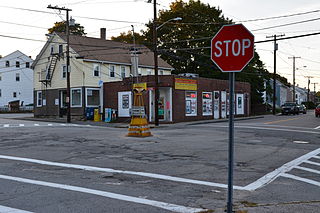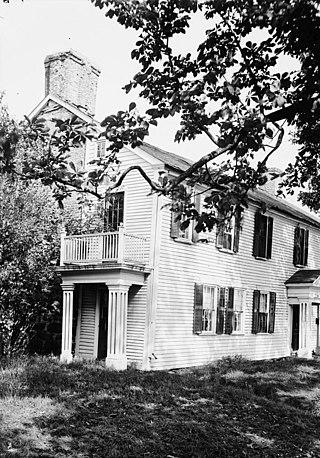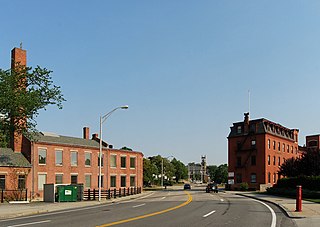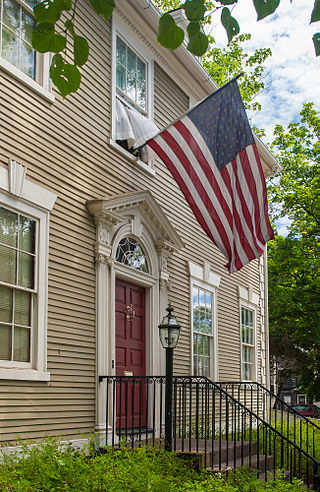
The Redwood Library and Athenaeum is a subscription library, museum, rare book repository and research center founded in 1747, and located at 50 Bellevue Avenue in Newport, Rhode Island. The building, designed by Peter Harrison and completed in March 1750, was the first purposely built library in the United States, and the oldest neo-Classical building in the country. It has been in continuous use since its opening.

The John Brown House is the first mansion built in Providence, Rhode Island, located at 52 Power Street on College Hill where it borders the campus of Brown University. The house is named after the original owner, one of the early benefactors of the university, merchant, statesman, and slave trader John Brown. It was declared a National Historic Landmark in 1968. John Quincy Adams considered it "the most magnificent and elegant private mansion that I have ever seen on this continent."

S. Stephen's Church is an historic Episcopal church located at 114 George Street in the College Hill neighborhood of Providence, Rhode Island. Located in the midst of the Brown University campus, it is an active parish in the Episcopal Diocese of Rhode Island, with a strong Anglo-Catholic identity.

Albion is a village and historic district in Lincoln, Rhode Island, in the United States.

The College Hill Historic District is located in the College Hill neighborhood of Providence, Rhode Island. It was designated a National Historic Landmark District on December 30, 1970. The College Hill local historic district, established in 1960, partially overlaps the national landmark district. Properties within the local historic district are regulated by the city's historic district zoning ordinance, and cannot be altered without approval from the Providence Historic District Commission.

The Nightingale–Brown House is a historic house at 357 Benefit Street on College Hill in Providence, Rhode Island. It is home to the John Nicholas Brown Center for Public Humanities and Cultural Heritage at Brown University. The house is architecturally significant as one of the largest surviving wood-frame houses of the 18th century, and is historically significant as the longtime seat of the Brown family, whose members have been leaders of the Providence civic, social, and business community since the 17th century, and include nationally significant leaders of America's industrialization in the 19th century. The house was listed on the National Register of Historic Places and declared a National Historic Landmark in 1989.

The Thomas Fenner House or the "Sam Joy Place" is a historic stone-ender house in Cranston, Rhode Island. It the oldest surviving house in the Providence Plantations portion of Rhode Island. The only older structure in the state is the White Horse Tavern in Newport. The house was built as a farmhouse in 1677 after King Philip's War by Captain Arthur Fenner for his son Major Thomas Fenner. The house was added to the National Register of Historic Places in 1990. The House is available for short stays by those interested in the historical and architectural significance of the property. It also is made available to educational groups to visit and study.

The Captain Stephen Olney House is a historic site in North Providence, Rhode Island. It is a 2+1⁄2-story wood-frame structure, five bays wide, with a pair of interior chimneys. The principal exterior decoration is in the front door surround, which features pilasters supporting an entablature and gable pediment. The house was built in 1802 by Stephen Olney, a veteran of the American Revolutionary War, on what was then a large farm. His descendants enlarged the house in the 1840s, adding an ell to the south.

The Joseph Smith House is a historic house at 109 Smithfield Road in North Providence, Rhode Island, United States. It is a 2½-story wood-frame house, six bays wide, with a shed-style addition to the rear giving it a saltbox appearance. The oldest portion of this house, built around 1705, is a classical Rhode Island stone-ender house, whose large chimney has since been completely enclosed in the structure. The lower levels of this chimney are believed to predate King Philip's War (1675–76), when the previous house was burned. The 1705 house was built by Joseph Smith, grandson of John Smith, the miller, one of Rhode Island's first settlers. It was greatly enlarged in 1762 by Daniel Jenckes, a judge from a prominent Rhode Island family, for his son, and was for many years in the hands of Jenckes' descendants. The house is the only known surviving stone-ender in North Providence.

St. Ann's Church Complex is now a historic cultural center in Woonsocket, Rhode Island on Cumberland Street. It was formerly a Roman Catholic church within the Diocese of Providence.

The Woods–Gerry House is an historic house on 62 Prospect Street in Providence, Rhode Island. It is a large, three story brick structure, designed by Richard Upjohn and built in 1860 for Dr. and Mrs. Marshall Wood. It is the largest surviving 19th-century house in Providence, measuring 55 feet (17 m) in width and 75 feet (23 m) in depth. It features restrained Italianate styling, most evident in its porch and porte-cochere, and in its roofline. The building currently houses the Admissions office for the Rhode Island School of Design.

Martin Hall, also known as the George M. Bradley House is a historic house on the upper campus of Providence College.

The Edward Dexter House is a historic house in the College Hill neighborhood of Providence, Rhode Island. It is a 2+1⁄2-story wood-frame structure, built in 1795–1797, with a hip roof topped by a square monitor. Its main facade is five bays wide, with the center bay flanked by two-story pilasters and topped by a small gable pediment. The well-preserved interior provided a template for an early-20th-century museum space designed by the Rhode Island School of Design to house a furniture collection donated by the house's then-owner, Charles Pendleton. The house is one of the few 18th-century houses in the city's College Hill neighborhood. It was originally located at the corner of George and Prospect Streets; in 1860 it was sawed in half and moved in sections to its present location.

The Thomas F. Hoppin House is a historic house at 383 Benefit Street in the College Hill neighborhood of Providence, Rhode Island. The house was built c. 1853 to a design by Alpheus C. Morse, and is an elaborate local example of an Italianate palazzo-style residence. The Library of Congress called the property "one of the largest and most elegant houses built in Providence in the mid-nineteenth century."

The Market House is a historic three-story brick market house in Market Square, in the College Hill, a neighborhood of Providence, Rhode Island, USA. The building was constructed between 1773 and 1775 and designed by prominent local architects, Joseph Brown and Declaration of Independence signer Stephen Hopkins. The bottom floor of the house was used as a market, and the upper level was used for holding meetings. Similar buildings existed in other American cities, such as Faneuil Hall in Boston and the Old Brick Market in Newport. The building housed the Providence City Council in the decades before the completion of City Hall.

Moshassuck Square is an industrial historic district in Providence, Rhode Island, lining the banks of the Blackstone Canal just north of the Rhode Island State House. It consists of the few surviving buildings of the once-extensive American Screw Company complex, which was largely developed between the 1840s and 1870s, and was a major fixture in the Providence landscape prior to its destruction by fire in 1971. The buildings are in an area bounded by Charles Street on the west, Stevens and Hewes Streets on the north, North Main Street to the east, and Mill Street to the south. Prominent among them are the Stillman White Foundry and Fletcher Manufacturing Company office building, which stand on opposite sides of Mill Street near its crossing of the canal. At 127 Charles Street stands a three-story brick building built c. 1900 as a retail and residential building. The only surviving elements of the Screw Company complex are located at North Main and Hewes Streets, and now house the Providence Center.

The Nathaniel Pearce House is an historic house at 305 Brook Street in Providence, Rhode Island. This Early Republican house is an "archetype of domestic design of its period". It was built in 1801 at 41 George Street on Brown's Main Green facing University Hall, where it enjoyed a view of Narragansett Bay. Nathaniel Pearce, a ship-master and ship-owner, purchased it circa 1780, doubled its size with a central hallway and new ornamental entrance and re-oriented to George Street in 1800. By 1888 it was owned by the Goddard family, who sold the George Street land to Brown University. Conditions of the sale required the house be either demolished or moved. John J. DeWolf bought the house and moved it to Brook Street in that year. In 1915, his nephew Halsey DeWolf, MD inherited the house and commissioned an expansion and colonial revival enhancements by his wife's cousin, architect Wallis E. Howe of Clarke & Howe. Landscape architects Searle & Searle refurbished the rear garden in the mid-1990s.

The Joseph and William Russell House is a historic house at 118 North Main Street in the College Hill area of Providence, Rhode Island. It is a brick Georgian house built in 1772. Its original interior woodwork has been removed and distributed among museums around the United States.

The Sludge Press House was an historic wastewater treatment facility building at the Fields Point Sewage Treatment Plant at Fields Point, Rhode Island in Providence, Rhode Island. It was a two-story brick structure, located near the center of the Field's Point facility, just east of the Chemical Building. It was about 138 by 51 feet in size, with a hip roof, and was built 1899-1901 as part of Providence's first wastewater treatment system. It housed the facilities used at the end of the treatment process by which remaining solids were dewatered and compressed before final disposal.

The Wedding Cake House, is a three-story historic house located at 514 Broadway Street in the Broadway-Armory Historic District of Providence, Rhode Island. Built in 1867 and occupied continuously until 1989, its contents were the subject of a 2001 exhibit at the Rhode Island School of Design Museum. It has had a variety of restoration work conducted since 2011.






















